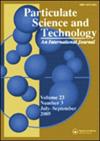粉末气动输送的最小输送边界建模
IF 1.5
4区 工程技术
Q3 ENGINEERING, CHEMICAL
引用次数: 0
摘要
摘要准确预测堵塞情况或最小输送边界对于气力输送系统的可靠设计和运行至关重要。许多现有的最小输运边界经验模型没有考虑基本的粉末特性和操作条件,如松散浇注的堆积密度、粒度和空气密度。根据13种不同粉体的输送结果,建立了最小输送边界的经验模型。该模型包括一个基于粒度和堆积密度的弗劳德数和一个无量纲的气体密度项,这使得该模型固有地适应粉末性能和操作条件的变化。验证结果表明,与现有模型的相对误差为19% ~ 67%相比,新模型对最小弗劳德数的预测有了显著提高(相对误差仅为7% ~ 13%)。关键词:气动输送;最小输送标准;改性颗粒管径数;;松散浇注容重;;“NTPC赞助的研究学者Gouarv Saluja感谢NTPC为他提供奖学金。”作者感谢塔帕尔工程技术研究所(TIET)与Granutools(比利时)在GranuHeap仪器使用方面的合作。披露声明作者未报告潜在的利益冲突本文章由计算机程序翻译,如有差异,请以英文原文为准。
Modeling minimum transport boundary for pneumatic conveying of powders
AbstractAccurate prediction of blockage conditions or the minimum transport boundary is essential for the reliable design and operation of a pneumatic powder conveying system. Many existing empirical models for minimum transport boundary do not consider essential powder properties and operating conditions, such as loose poured bulk density, particle size, and air density. Based on the conveying results of 13 different powders, this paper has developed a new empirical model for the minimum transport boundary. The model includes a Froude number based on particle size and bulk density and a dimensionless gas density term, which makes the model inherently adaptable to variations in powder properties and operating conditions. Results of validation show that the new model provides a significantly improved prediction of minimum Froude Number (in the range of 7 to 13% relative error only) compared to the existing models, which provided relative errors in the range of 19 to 67%.Keywords: Pneumatic conveyingminimum transport criteriamodified particle froude numberloose poured bulk densityparticle sizeconveying air density AcknowledgmentThe authors would like to thank NTPC Ltd., India, for the sponsored research project – sanction letter ref. 9100000168-151-1001.“NTPC sponsored Research Scholar, Gouarv Saluja, would like to thank NTPC for providing him scholarship.”The authors would like to acknowledge the collaboration between Thapar Institute of Engineering & Technology (TIET) and Granutools (Belgium) for the use of GranuHeap instrument.Disclosure statementNo potential conflict of interest was reported by the author(s)
求助全文
通过发布文献求助,成功后即可免费获取论文全文。
去求助
来源期刊

Particulate Science and Technology
工程技术-工程:化工
CiteScore
4.40
自引率
4.00%
发文量
86
审稿时长
12 months
期刊介绍:
Particulate Science and Technology, an interdisciplinary journal, publishes papers on both fundamental and applied science and technology related to particles and particle systems in size scales from nanometers to millimeters. The journal''s primary focus is to report emerging technologies and advances in different fields of engineering, energy, biomaterials, and pharmaceutical science involving particles, and to bring institutional researchers closer to professionals in industries.
Particulate Science and Technology invites articles reporting original contributions and review papers, in particular critical reviews, that are relevant and timely to the emerging and growing fields of particle and powder technology.
 求助内容:
求助内容: 应助结果提醒方式:
应助结果提醒方式:


